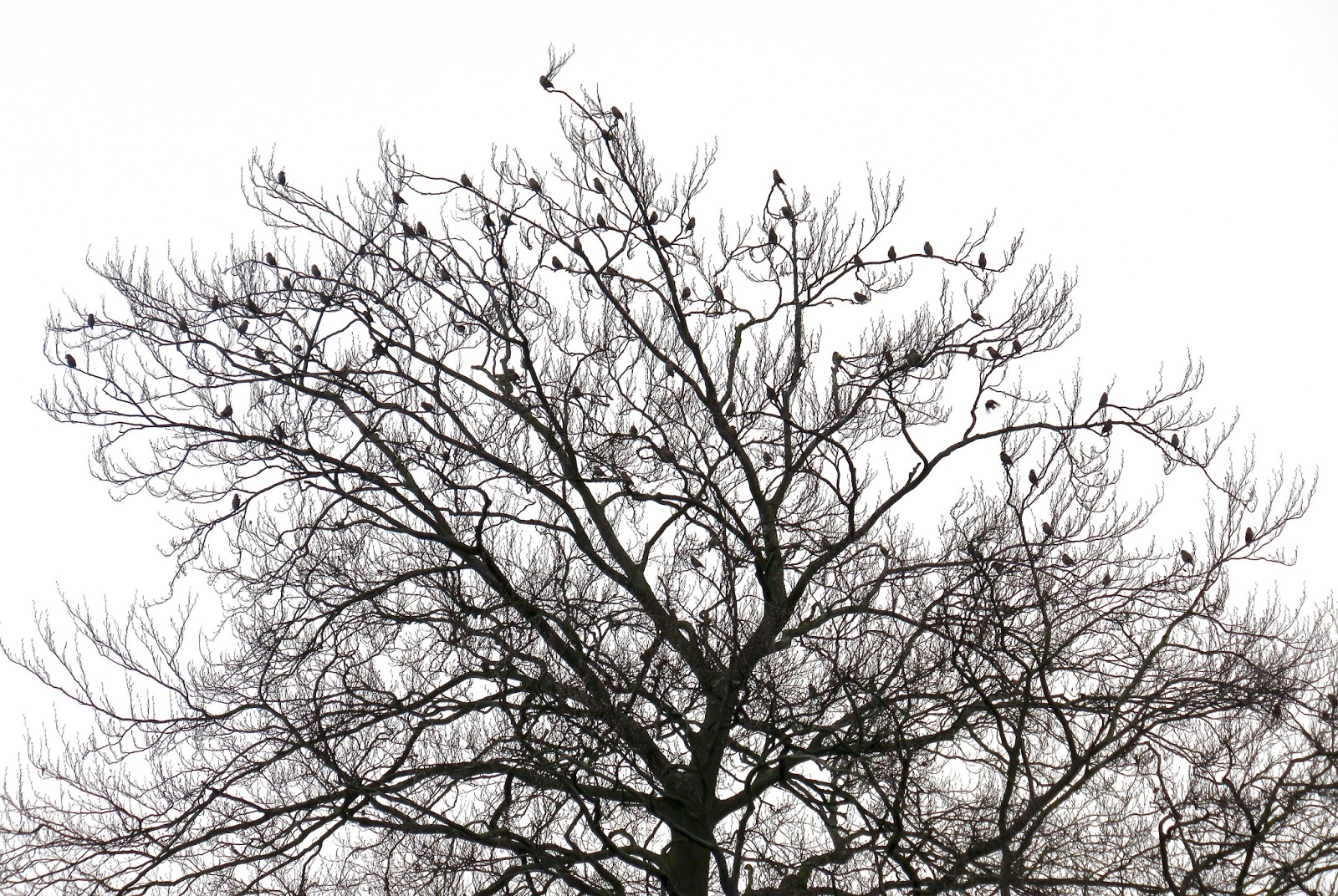600
Where to begin?
Yesterday evening might be a good place. I was delighted to see that two Sussex stalwarts - Chris Janman and Dick Senior - had recorded 400+ Hawfinches at Kingley Vale that very morning, one of the few areas in the country that can out-Yew Mickleham and Box Hill. I was already planning on visiting Bramblehall Wood the following morning (today) and their success got me wondering as to whether or not flocks were starting to join forces, or that I would find the Surrey woodland to be a lot quieter as the birds had all moved to Sussex!
I was in the Whitehill Carpark by 06.15hrs and within ten minutes found myself staring across the field and into the tree tops of Bramblehall Wood. I was frankly surprised to see, at this early hour, at least 200 Hawfinches already on show (part of the flock pictured above). They were quite motionless and, I think it safe to assume, had just emerged from a very close roosting site. Over the following hour more birds arrived (mainly from the direction of Ashurst Rough) to join them. From time to time numbers left the tree tops to dive into the wall of Yew beneath, birds being observed moving amongst the foliage as they fed, barging through the vegetation. A flock of c100 then took to the air and headed purposefully northwards along the tree-line, appearing to disappear towards High Ashurst Outdoor Centre, not to be seen again. The rest of the birds then moved off southwards, then settled some 400m further along. At 07.15 things started to get very busy indeed. It began with a lose flock of 200 birds that came in over my head and circled the birds that were already present in front of me. Those in the trees then also took to the air - not the 100+ that I had assumed were present but at least 250 of them - and I was witness to a kaleidoscope of Hawfinches, a blizzard of wing-bars, tail-tips and excited calling. 450+ birds in all. Plus, there were 50+ birds behind me, up in the Yews. Together with the 100 that had left northwards earlier in the morning that made for a minimum of 600. Incredible. And do you know what happened to this mass of Hawfinches? They just melted away. Gone with barely a whimper, to be consumed by that dense wall of Yew trees. All became very quiet indeed.
Back on the footpath I bumped into west-Surrey birder Malcolm Lawford, and together we retraced my steps, but by 08.00hrs could (only!) find 100+ birds. Again, the assumption was taken that these were birds that I had already counted. And this neatly demonstrates how skewed birding perspective can become, as these 100+ seemed like a let-down, small potatoes, a failure. 100!! In most years you would crawl over broken glass to see such a gathering.
Was this boost in number (from a previous high of 420 on 22 February) a genuine increase from birds that had recently come into the area? Or had such a number been here all the time but had just eluded observers? I take the recording of these large Hawfinch flocks seriously. There is a responsibility involved in obtaining accurate counts, for these numbers are of historical proportions. That count of 600 is a bare minimum. It assumes that every bird that appears in front of me from an area where I have already seen/counted a Hawfinch must be a repeat bird. Every time a flock of 50 birds flies to the left and 40 come back 10 minutes later, they must be some of the same. I need to take such a strict stance so that there can be no chance of an incorrect, higher total. But at the same time it is worth bearing in mind that they just might be different birds... at least some of the time.
I then went on a tour of the nearby sites. I can only describe the immediate area as dripping with Hawfinches. Almost every scan over distant treetops would yield perched birds, overflying flocks or unseen birds that would 'tick' and 'seep' from nearby cover. The southern slope of Mickleham Downs was given a half-hour scan which yielded at least 46 birds. Lodge Hill had a flock of five. And Juniper Bottom (scene of the famous 2013 flock) held at least 115, although these may well have been birds that had earlier been at Bramblehall - but then again, they might not have been. While I was here I started to watch a high spiralling Sparrowhawk, and, just within the range of being able to identify them, a high flock of 8 Hawfinches flew through my field of view, heading northwards. They, at least, seemed to be finally on the move.



Comments
Disregarding any competitive element to this event, I imagine it's safe to say, you've probably seen more Hawfinches than anyone.
Meanwhile, I'll satisfy myself with somewhat smaller numbers of this somewhat enigmatic species.
Wheatears soon. Hopefully.
All the best,
Pete Coates